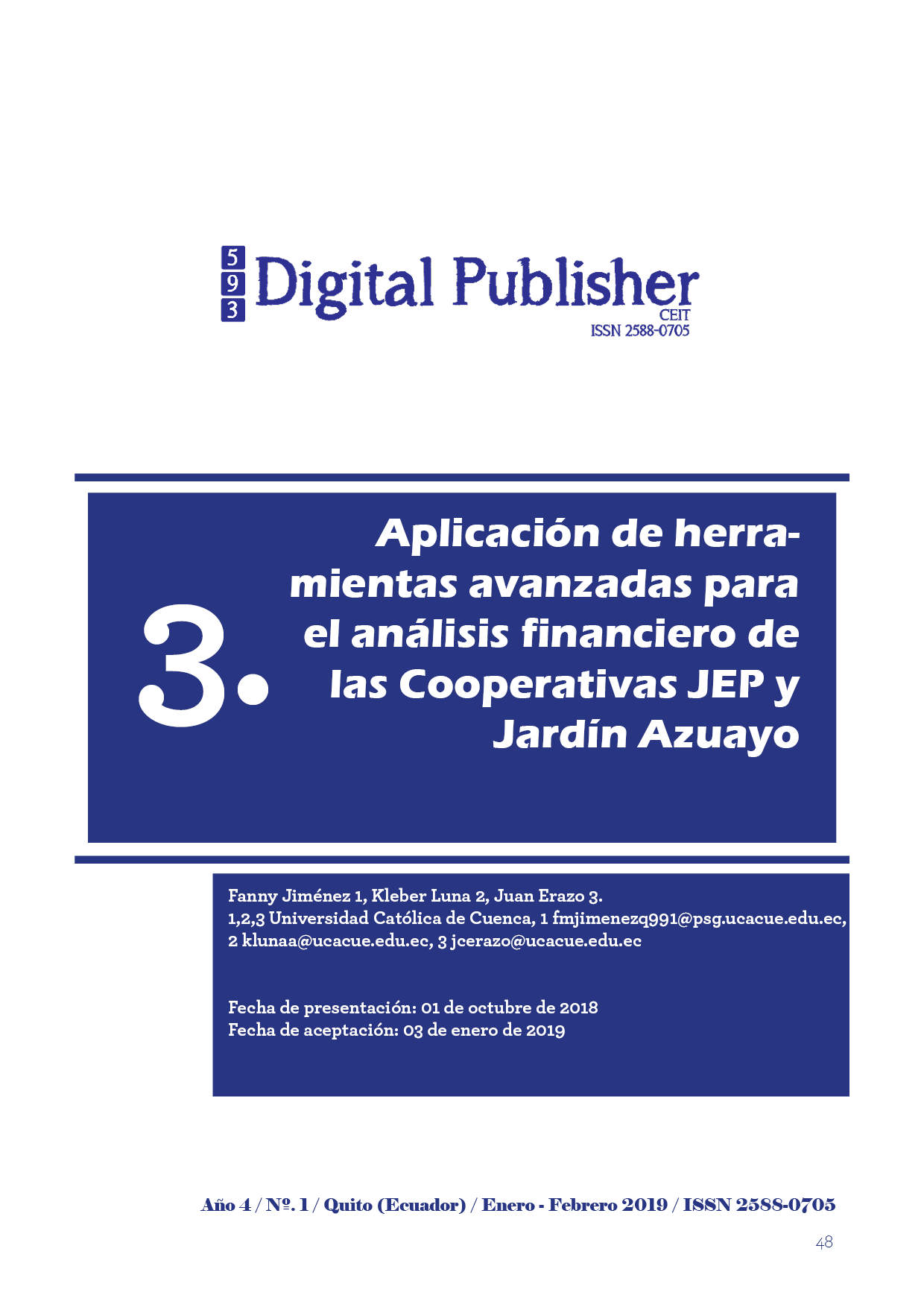Application of advanced tools for financial analysis of cooperatives JEP and Jardin Azuayo
Main Article Content
Abstract
Financial analysis in Ecuador's traditional economy is not entirely effective, due to its own nature and imprecise, since it generates uncertain data that leads to deficient projected results, affecting the stability of entities over time. The objective of this research is based on the application of highly competitive and reliable advanced tools, starting from the theory of fuzzy logic applied to the financial field, which allows converting the traditional static balances of the cooperatives Juventud Ecuatoriana Progresista and Jardin Azuayo into dynamic pension balances; for which a model called fuzzy automation is incorporated, in which the theory of the fuzzy subsets is developed, technique that incorporates the uncertainty and subjectivity for the analysis of the accounting information, the tools used in the process of dynamization start from the opinion given by the experts, using the techniques of the expertizaje and counter-expertizaje, converting the patrimonial masses in intervals of confidence that capture and reduce drastically the uncertainty, generating value for the entity and efficiency in the taking of decisions. By applying the main financial ratios using blurred mathematics, an accounting model is proposed for administrative decision making that facilitates entities to maintain themselves in a world of continuous change, providing prediction in the results of working capital, solvency and profit indicators, in which it is estimated that each of the cooperatives must adopt transcendental and sustainable changes that strengthen its structure in the future.
Downloads
Article Details
1. Derechos de autor
Las obras que se publican en 593 Digital Publisher CEIT están sujetas a los siguientes términos:
1.1. 593 Digital Publisher CEIT, conserva los derechos patrimoniales (copyright) de las obras publicadas, favorece y permite la reutilización de las mismas bajo la licencia Licencia Creative Commons 4.0 de Reconocimiento-NoComercial-CompartirIgual 4.0, por lo cual se pueden copiar, usar, difundir, transmitir y exponer públicamente, siempre que:
1.1.a. Se cite la autoría y fuente original de su publicación (revista, editorial, URL).
1.1.b. No se usen para fines comerciales u onerosos.
1.1.c. Se mencione la existencia y especificaciones de esta licencia de uso.
References
Bernal-Dominguez, D., y Amat-Salas, O. (2012). Anuario de ratios financieros sectoriales en México para análisis comparativo empresarial. Ra Ximhai, 8(2), 271-286. Retrieved from http://uaim.edu.mx/webraximhai/Ej-24articulosPDF/ARTICULO_06.pdf
Escobedo, J. (2017). Análisis financiero comparativo BANORTE–INBURSA. Tecsistecatl. Economía y Sociedad de México, 9(21). Retrieved from http://www.eumed.net/rev/tecsistecatl/n21/banorte-inbursa.html
Gil, J. (2005). La matemática borrosa en economía y gestión de empresas. Matematicalia: revista digital de divulgación matemática de la Real Sociedad Matemática Española, 1(3), 5. Retrieved from https://imarrero.webs.ull.es/sctm05/modulo1tf/1/jgil.pdf
Kaufmann, A., y Gil - Aluja, J. (1986). Introducción de la teoría de los subconjuntos borrosos a la gestión de las empresas. Milladoiro: Santiago de Compostela, España.
Lafuente, A. (2001). Nuevas Estrategias para el análisis financiero en la empresa. Ariel.
León, D. (2015). Modelo predictivo para riesgo de liquidez de una entidad fiduciaria usando minería de datos. Tesis Doctoral, Universidad Nacional de Colombia- Bogotá, 1-56. Retrieved from http://bdigital.unal.edu.co/51173/1/53038441.2015.pdf
Maldonado, K. (2007). Evaluación de la aplicación de la metodología de banca comunal en Ecuador. Tesis de Maestría. Universidad Andina Simón Bolívar, Sede Ecuador, 1-136. Retrieved from http://repositorionew.uasb.edu.ec/handle/10644/814
Medina, S. (2006). Estado de la cuestión acerca del uso de la lógica difusa en problemas financieros. Cuadernos de Administración, 19(32), 1-29. Retrieved from https://www.researchgate.net/profile/Santiago_Medina_Hurtado/publication/255612573_Estado_de_la_cuestion_acerca_del_uso_de_la_logica_difusa_en_problemas_financieros/links/557380b208aeb6d8c019299d/Estado-de-la-cuestion-acerca-del-uso-de-la-logica-difusa-en-problemas-financieros.pdf
Medina, S., y Paniagua, G. (2008). Modelo de inferencia difuso para estudio de crédito. Dyna, 75(154), 215-229. Retrieved from https://www.redalyc.org/html/496/49615421/
Morales, G. (2002). Introducción a la Lógica Difusa. Centro de Investigación y Estudios Avanzados del IPN. México, 1-5. Retrieved from http://casanchi.com/mat/intrologicadifusa01.pdf
Reig, J., y González, J. (2002). Modelo Borroso de control de gestión de materiales. Spanish Journal of Finance and Accounting/Revista Española de Financiación y Contabilidad, 31(112), 431-459. Retrieved from https://www.jstor.org/stable/42781484
Rico, M., y Tinto, J. (2009). Matemática borrosa: algunas aplicaciones en las ciencias económicas, administrativas y contables. Contaduría Universidad de Antioquia(52), 199-214. Retrieved from http://aprendeenlinea.udea.edu.co/revistas/index.php/cont/article/view/2169
Romero, F. (2013). Alcances y limitaciones de los modelos de capacidad predictiva en el análisis del fracaso empresarial. AD-minister(23), 45-47. Retrieved from http://publicaciones.eafit.edu.co/index.php/administer/article/view/2243/2194
Tinto, A., Molina, M., Chavez, H., y Mosquera, S. (2016). Automatización Fuzzy aplicado en la contabilidad decisional. ECA Sinergía, 2-18. Retrieved from https://186.46.160.238/index.php/ECASinergia/article/view/210
Tinto, J., Molina, M., y Chávez, H. (2015). Instrumentos Fuzzy para la toma de decisiones en las ciencias contables. ECA Sinergia, 6(1), 42-56. Retrieved from de https://186.46.160.238/index.php/ECASinergia/article/view/220/180
Zadeh, L. (1965). Fuzzy Sets, Informationand Control.

